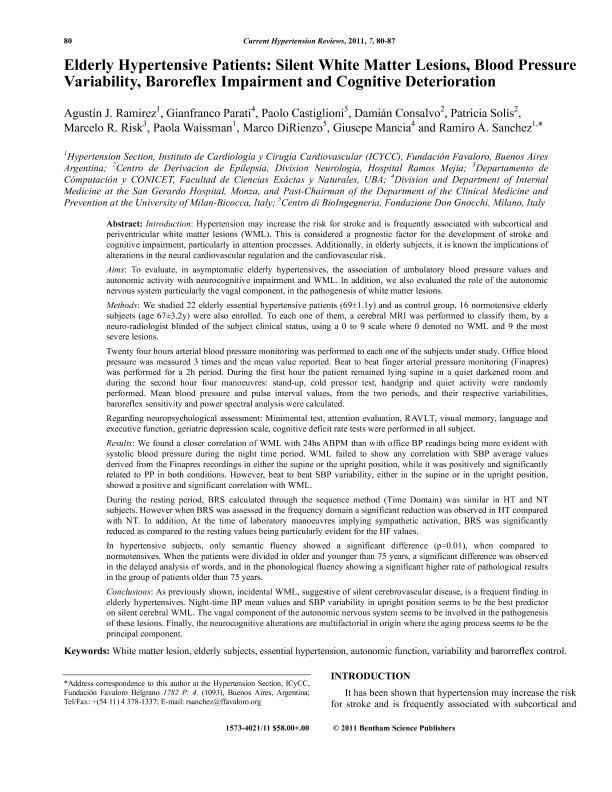Mostrar el registro sencillo del ítem
dc.contributor.author
Ramírez, Agustín José

dc.contributor.author
Parati, Gianfranco
dc.contributor.author
Castiglioni, Paolo
dc.contributor.author
Consalvo, Damian

dc.contributor.author
Solis, Patricia Cristina Lourdes

dc.contributor.author
Risk, Marcelo

dc.contributor.author
Waissman, Paola
dc.contributor.author
di Rienzo, Marco
dc.contributor.author
Mancia, Giusepe
dc.contributor.author
Sanchez, Ramiro A.
dc.date.available
2023-04-13T19:18:02Z
dc.date.issued
2011-10
dc.identifier.citation
Ramírez, Agustín José; Parati, Gianfranco; Castiglioni, Paolo; Consalvo, Damian; Solis, Patricia Cristina Lourdes; et al.; Elderly hypertensive patients: Silent white matter lesions, blood pressure variability, baroreflex impairment and cognitive deterioration; Bentham Science Publishers; Current Hypertension Reviews; 7; 2; 10-2011; 80-87
dc.identifier.issn
1875-6506
dc.identifier.uri
http://hdl.handle.net/11336/193767
dc.description.abstract
Introduction: Hypertension may increase the risk for stroke and is frequently associated with subcortical and periventricular white matter lesions (WML). This is considered a prognostic factor for the development of stroke and cognitive impairment, particularly in attention processes. Additionally, in elderly subjects, it is known the implications of alterations in the neural cardiovascular regulation and the cardiovascular risk. Aims: To evaluate, in asymptomatic elderly hypertensives, the association of ambulatory blood pressure values and autonomic activity with neurocognitive impairment and WML. In addition, we also evaluated the role of the autonomic nervous system particularly the vagal component, in the pathogenesis of white matter lesions. Methods: We studied 22 elderly essential hypertensive patients (69±1.1y) and as control group, 16 normotensive elderly subjects (age 67±3.2y) were also enrolled. To each one of them, a cerebral MRI was performed to classify them, by a neuro-radiologist blinded of the subject clinical status, using a 0 to 9 scale where 0 denoted no WML and 9 the most severe lesions. Twenty four hours arterial blood pressure monitoring was performed to each one of the subjects under study. Office blood pressure was measured 3 times and the mean value reported. Beat to beat finger arterial pressure monitoring (Finapres) was performed for a 2h period. During the first hour the patient remained lying supine in a quiet darkened room and during the second hour four manoeuvres: stand-up, cold pressor test, handgrip and quiet activity were randomly performed. Mean blood pressure and pulse interval values, from the two periods, and their respective variabilities, baroreflex sensitivity and power spectral analysis were calculated. Regarding neuropsychological assessment: Minimental test, attention evaluation, RAVLT, visual memory, language and executive function, geriatric depression scale, cognitive deficit rate tests were performed in all subject. Results: We found a closer correlation of WML with 24hs ABPM than with office BP readings being more evident with systolic blood pressure during the night time period. WML failed to show any correlation with SBP average values derived from the Finapres recordings in either the supine or the upright position, while it was positively and significantly related to PP in both conditions. However, beat to beat SBP variability, either in the supine or in the upright position, showed a positive and significant correlation with WML. During the resting period, BRS calculated through the sequence method (Time Domain) was similar in HT and NT subjects. However when BRS was assessed in the frequency domain a significant reduction was observed in HT compared with NT. In addition, At the time of laboratory manoeuvres implying sympathetic activation, BRS was significantly reduced as compared to the resting values being particularly evident for the HF values. In hypertensive subjects, only semantic fluency showed a significant difference (p=0.01), when compared to normotensives. When the patients were divided in older and younger than 75 years, a significant difference was observed in the delayed analysis of words, and in the phonological fluency showing a significant higher rate of pathological results in the group of patients older than 75 years. Conclusions: As previously shown, incidental WML, suggestive of silent cerebrovascular disease, is a frequent finding in elderly hypertensives. Night-time BP mean values and SBP variability in upright position seems to be the best predictor on silent cerebral WML. The vagal component of the autonomic nervous system seems to be involved in the pathogenesis of these lesions. Finally, the neurocognitive alterations are multifactorial in origin where the aging process seems to be the principal component.
dc.format
application/pdf
dc.language.iso
eng
dc.publisher
Bentham Science Publishers

dc.rights
info:eu-repo/semantics/openAccess
dc.rights.uri
https://creativecommons.org/licenses/by-nc-sa/2.5/ar/
dc.subject
AUTONOMIC FUNCTION
dc.subject
ELDERLY SUBJECTS
dc.subject
ESSENTIAL HYPERTENSION
dc.subject
VARIABILITY AND BARORREFLEX CONTROL
dc.subject
WHITE MATTER LESION
dc.subject.classification
Sistemas Cardíaco y Cardiovascular

dc.subject.classification
Medicina Clínica

dc.subject.classification
CIENCIAS MÉDICAS Y DE LA SALUD

dc.title
Elderly hypertensive patients: Silent white matter lesions, blood pressure variability, baroreflex impairment and cognitive deterioration
dc.type
info:eu-repo/semantics/article
dc.type
info:ar-repo/semantics/artículo
dc.type
info:eu-repo/semantics/publishedVersion
dc.date.updated
2023-04-13T14:12:34Z
dc.identifier.eissn
1573-4021
dc.journal.volume
7
dc.journal.number
2
dc.journal.pagination
80-87
dc.journal.pais
Países Bajos

dc.journal.ciudad
Soest
dc.description.fil
Fil: Ramírez, Agustín José. Fundación Favaloro; Argentina. Consejo Nacional de Investigaciones Científicas y Técnicas; Argentina
dc.description.fil
Fil: Parati, Gianfranco. San Gerardo Hospital; Italia. University of Milan-Bicocca; Italia
dc.description.fil
Fil: Castiglioni, Paolo. Fondazione Don Gnocchi; Italia
dc.description.fil
Fil: Consalvo, Damian. Gobierno de la Ciudad de Buenos Aires. Hospital General de Agudos "Ramos Mejía"; Argentina
dc.description.fil
Fil: Solis, Patricia Cristina Lourdes. Gobierno de la Ciudad de Buenos Aires. Hospital General de Agudos "Ramos Mejía"; Argentina
dc.description.fil
Fil: Risk, Marcelo. Universidad de Buenos Aires. Facultad de Ciencias Exactas y Naturales. Departamento de Computación; Argentina. Consejo Nacional de Investigaciones Científicas y Técnicas; Argentina
dc.description.fil
Fil: Waissman, Paola. Fundación Favaloro; Argentina
dc.description.fil
Fil: di Rienzo, Marco. Fondazione Don Gnocchi; Italia
dc.description.fil
Fil: Mancia, Giusepe. San Gerardo Hospital; Italia. University of Milan-Bicocca; Italia
dc.description.fil
Fil: Sanchez, Ramiro A.. Fundación Favaloro; Argentina
dc.journal.title
Current Hypertension Reviews
dc.relation.alternativeid
info:eu-repo/semantics/altIdentifier/url/https://www.eurekaselect.com/article/20240
dc.relation.alternativeid
info:eu-repo/semantics/altIdentifier/doi/http://dx.doi.org/10.2174/157340211797457908
Archivos asociados
